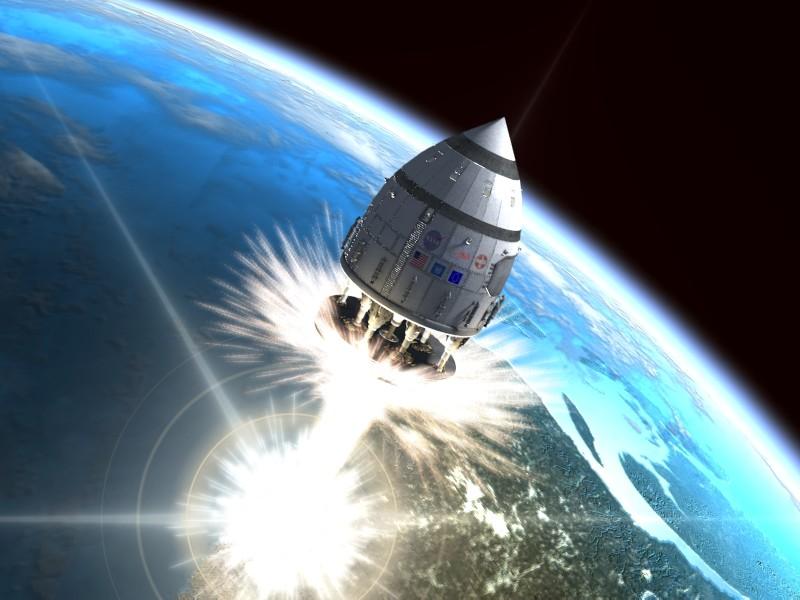Image credit
Rockets are nifty for getting off Earth's surface, but their exhaust is slow compared to the speeds needed to venture into the solar system. This means that chemical rocket engines need a tremendous amount of propellant to go anywhere quickly, and more efficient alternatives with high exhaust velocity like ion engines and Hall effect thrusters create pitifully small thrust compared to the power they need to operate. It would be nice to have a spacecraft engine that creates lots of thrust with hot, fast exhaust, and that wouldn't require a gigantic powerplant to run. Why not power your spaceship with a series of nuclear bombs? A research team at General Atomic, led by virtuoso weapons designer Ted Taylor and all-around badass physicist Freeman Dyson and funded by the Defense Advanced Research Projects Administration (DARPA), looked into this idea in the late 1950s and early 1960s. You can read more about that here:
Project Orion
The concept is stupidly brilliant, the kind of thing a 5-year-old would propose and her parents would later be startled to realize could actually work. A nuclear explosive device is a relatively lightweight machine that can generate an obscene amount of power for a short period of time. Detonate one after another after another just behind your ship, and you're bound to be pushed forward rather quickly by the stream of apocalyptic nuclear invective headed your way. It may seem like nothing built by human hands could survive such an environment, but it turns out that when placed near the conditions in a nuclear explosion most metals behave in an odd way. A thin (atoms-thick) surface layer vaporizes within microseconds of the heat pulse's onset, but that layer is almost completely opaque to the incoming ultraviolet and X-rays from the explosion. That opacity protects the rest of the thick, sturdy pusher plate and keeps its temperature low enough to hold together. Add large, very sturdy shock absorbers and springs to connect the pusher plate to the ship while keeping the crushing vibration of the nuke-nuke-nuke pulse tolerable, and you're ready to fly.
The capabilities of an Orion-type ship relative to the spacecraft we've operated so far in our space programs are jaw-dropping. Once the Orion research team realized that none of the physics problems with nuclear pulse propulsion (as it's technically referred to) are intractable, or even terribly difficult to solve, they began seriously talking about launching destroyer-size ships with crews of 100 to Mars by the middle of the 1960s and to the moons of Saturn by the end of the decade. The concept scales up better than it scales down, so the larger ship for outer planet exploration would be fast almost beyond imagination, reaching Saturn in a matter of months. Contrast that with the voyage of Cassini, the only spacecraft ever to orbit the sixth major planet, which took seven years to get there, and will never be able to return since she used all her propellant en route and on arrival. There was even talk of building city-size colony ships to embark on a century-long trek to Alpha Centauri. Forget the pyramids of Giza, the walls of China, and the cathedrals of Europe. This would be the greatest monument to the ingenuity, teamwork, and motivation of humanity in all our history.
There are good reasons not to use nuclear pulse propulsion in real life, as the reader has probably already guessed. Detonated within Earth's atmosphere, pulse units (as the nuclear explosives used for propulsion were euphemistically called) irradiate soil, dust, and air itself, creating significant fallout with every launch. Outside of the atmosphere, the radiation created by nuclear explosions is trapped in Earth's magnetosphere, intensifying the lethality of the Van Allen radiation belts and showering satellites everywhere with circuit-board-frying X-rays and charged particles. Orion ships don't make good neighbors. It was for this reason, along with the shift toward the various R&D programs of Project Apollo, that research into the concept was shelved.
Granted, the plans to send Orion ships to Mars and Saturn while the Vietnam War still raged were irrationally exuberant. But as Carl Sagan points out in the video below, Orion is entirely practical, as bewildering as that sounds. We can do this, now. We don't need a breakthrough in materials science or computer modelling or the production and containment of antimatter to transform a journey to the planets of Alpha Centuari from a dream into an historical fact. We need only the will to do so.

It's not often in real science that you get to call something "so crazy it just might work," but nuclear pulse definitely fits the bill.
ReplyDelete